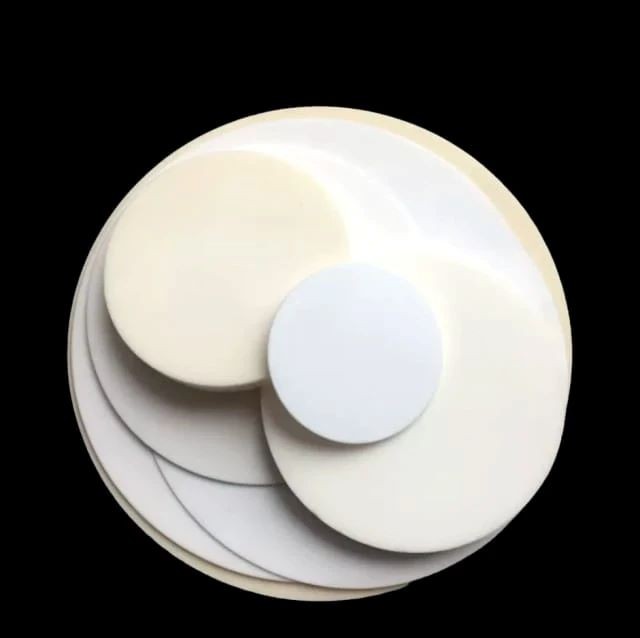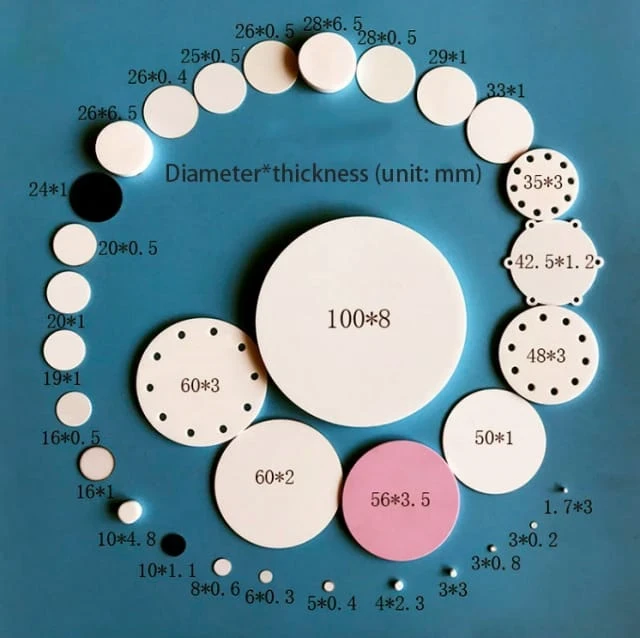
为什么选择我们
可靠的合作伙伴简易的订购流程、优质的产品和专业的支持,助力您的业务成功。
应用
陶瓷散热器是电器中用于散热电子元件的装置。陶瓷散热器的孔洞结构增加了与空气接触的散热面积,大大增强了散热效果,其散热效果优于超铜和铝。陶瓷绝缘、耐高温、耐氧化、耐酸碱、热冲击、热膨胀系数低,确保在高低温或其他恶劣环境下的稳定性。陶瓷能承受大电流,承受高电压,防止漏电击穿,无噪音,不会与MOS等功率管产生耦合寄生电容,从而简化了滤波过程。
- 高温下仍保持硬度,可用作工业炉材料。
- 用于制造CVD、离子注入、光刻和半导体零件。
- 在传统工业中,氧化铝陶瓷用于注管、燃气喷嘴和绝缘子等产品。
- LED照明、扬声器/音频、功率晶体管、功率模块等以及一些大功率设备。
- IC、MOS、三极管、肖特基、IGBT等需要散热的表面热源!
- 特别适用于大功率设备,设计空间特别适合轻、薄、短、小。
详情与零件






技术规格
| 1.7*3毫米 | 10*4毫米 | 16*1毫米 | 20*20毫米 | 29.5*1毫米 | 60*1毫米 | 100*8毫米 |
| 3*3毫米 | 10*5毫米 | 16*4毫米 | 20.5*1毫米 | 30.5*1毫米 | 57.8*6毫米 | 107*3毫米 |
| 4*2.3毫米 | 10.5*2毫米 | 16*5毫米 | 22*1毫米 | 32*5毫米 | 70*1毫米 | 150*5毫米 |
| 6*6毫米 | 10.5*10.5毫米 | 17*1毫米 | 23.5*2.5毫米 | 35*1毫米 | 74*1毫米 | 200*5毫米 |
| 7*3.3毫米 | 12*1毫米 | 18*0.63毫米 | 25*0.5毫米 | 40*1毫米 | 80*1毫米 | |
| 8*5毫米 | 12*5毫米 | 19*0.8毫米 | 26*4毫米 | 45*0.5毫米 | 90*1毫米 | |
| 9.5*1.3毫米 | 14*1毫米 | 20*1毫米 | 26*5毫米 | 51*1毫米 | 100*1毫米 | |
| 10*1毫米 | 16*0.5毫米 | 20*10毫米 | 28*6.5毫米 | 50*5毫米 | 100*2毫米 |
我们展示的产品有多种尺寸可供选择,并可根据要求定制尺寸。
优点
- 与同等体积的铝散热器相比,陶瓷型号具有多孔性,增加了散热表面积。
- 无储热,直接散热,多方向散热,进一步加快散热速度。
- 多晶性质,提高散热速率。
- 陶瓷绝缘、耐高温、耐氧化、耐酸碱、使用寿命长。
- 有效的抗干扰(EMI)和抗静电。
- 天然无机材料符合环保要求。
- 其绝缘性能赋予其高电阻率,其质地使其稳定、耐高温且重量轻。
FAQ
精细陶瓷的主要用途有哪些?
散热器选择比较。
精密陶瓷的主要类型有哪些?
精密陶瓷的原理是什么?
使用精密陶瓷有哪些优势?
4.8
out of
5
I am amazed by its high temperature stability and thermal conductivity.
4.9
out of
5
The ceramic heat sink is fantastic, it dissipates heat efficiently and ensures stability in various environments.
4.7
out of
5
The alumina ceramic crucible's insulation properties and mechanical strength are exceptional, making it perfect for high-temperature applications.
4.9
out of
5
The tungsten boats with alumina barrier offer excellent heat concentration, preventing sample creeping and wetting.
4.6
out of
5
The ceramic heat sink's porosity increases the surface area for heat dissipation, resulting in faster cooling.
4.7
out of
5
The alumina ceramic's hardness and wear-resistance make it ideal for wear-resistant inserts and products.
4.8
out of
5
The alumina's resistance to strong acids and alkalis at elevated temperatures makes it suitable for corrosive environments.
4.9
out of
5
The ceramic heat sink's ability to withstand large currents and high voltages prevents leakage breakdown and simplifies filtering.
4.7
out of
5
The alumina's high hardness at high temperatures makes it a suitable material for industrial furnaces.
4.8
out of
5
The alumina's applications in CVD, ion implantation, lithography, and semiconductor parts are highly valuable.
4.9
out of
5
The alumina ceramics' use in injection pipes, gas nozzles, and insulators in traditional industries is commendable.
4.6
out of
5
The ceramic heat sink's compact design is perfect for light, thin, short, and small spaces, especially in high-power equipment.
4.7
out of
5
The alumina's insulating properties provide high electrical resistance and stability under extreme conditions.
4.8
out of
5
The ceramic heat sink's multi-directional heat dissipation speeds up the cooling process significantly.
4.9
out of
5
The alumina's polycrystalline nature enhances the rate of heat dissipation, making it highly efficient.
4.7
out of
5
The ceramic heat sink's effective anti-interference and anti-static properties ensure reliable performance.
获取报价
我们的专业团队将在一个工作日内回复您。请随时与我们联系!
相关产品

在科学探索和工业生产的征程中,每一个细节都至关重要。我们的弧形氧化铝陶瓷坩埚,凭借其出色的耐高温性和稳定的化学性质,已成为实验室和工业领域的得力助手。它们采用高纯度氧化铝材料制成,并经过精密工艺制造,确保在极端环境下也能有卓越的表现。

工程高级陶瓷氧化铝坩埚(Al2O3),用于热分析TGA DTA
TGA/DTA热分析用坩埚采用氧化铝(刚玉或氧化铝)制成。它耐高温,适用于需要高温测试的材料分析。
相关文章

电极夹具指南:类型、设计和应用
了解电极夹具的全面指南,涵盖各种类型、设计注意事项以及电极夹具在电镀、焊接和电化学电池等行业中不可或缺的作用。

安装二硅化钼(MoSi2)加热元件时的注意事项
安装 MoSi2 加热元件时的注意事项

调查影响箱式炉缓慢升温的因素
有时,炉温可能不会像预期的那样迅速升高,或者根本无法达到理想的温度。

高级氧化铝陶瓷:应用与制造技术
本文讨论了先进氧化铝陶瓷的应用和制造技术,包括模具、等静压和绿色坯体。

高级氧化铝陶瓷:应用与制造技术
氧化铝陶瓷的应用和制造方法概述,包括模具、等静压和绿色体成型。

了解氧化物陶瓷:概念、分类和应用
本文深入探讨了氧化物陶瓷的概念、分类和各种应用,强调了其在各种高科技领域的重要意义。

半导体应用中的精密陶瓷
探索半导体设备中精密陶瓷的使用、特性和制造工艺。

目前最热门的 5 种先进陶瓷粉!
概述五大先进陶瓷粉:高纯氧化铝、波美度石、氮化铝、氮化硅和球形氧化铝,重点介绍其应用和市场趋势。

金属新材料推动人工智能芯片进步
探讨新型金属材料如何推动人工智能芯片升级,影响计算能力和半导体制造。

高温工程陶瓷的结构与性能
探索高温工程陶瓷在各行各业的应用、结构特点和性能优势。

工程陶瓷材料:航空航天、电子信息、新能源和环境保护领域的应用
本文探讨了工程陶瓷材料在航空航天、电子信息、新能源和环境保护等领域的各种应用。

用于能源转换应用的精密陶瓷材料
概述能源转换技术中使用的各种陶瓷材料,包括加热器、压电陶瓷和固体氧化物燃料电池。
















